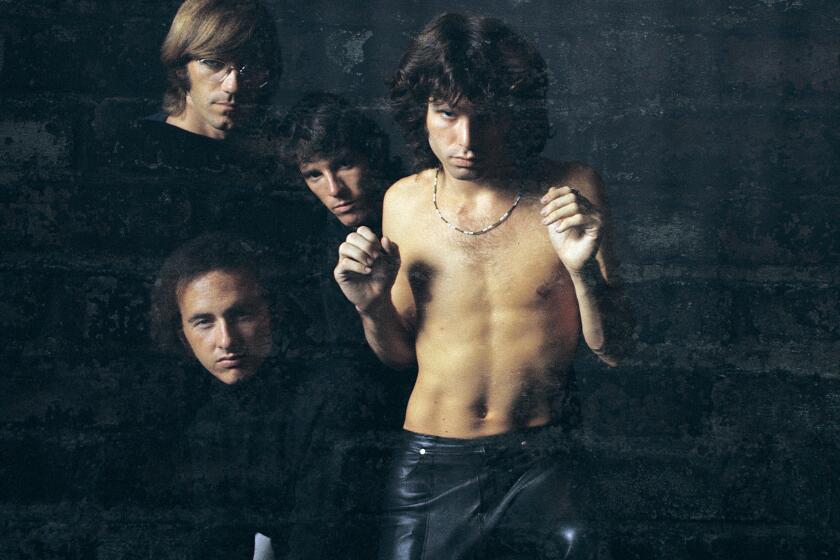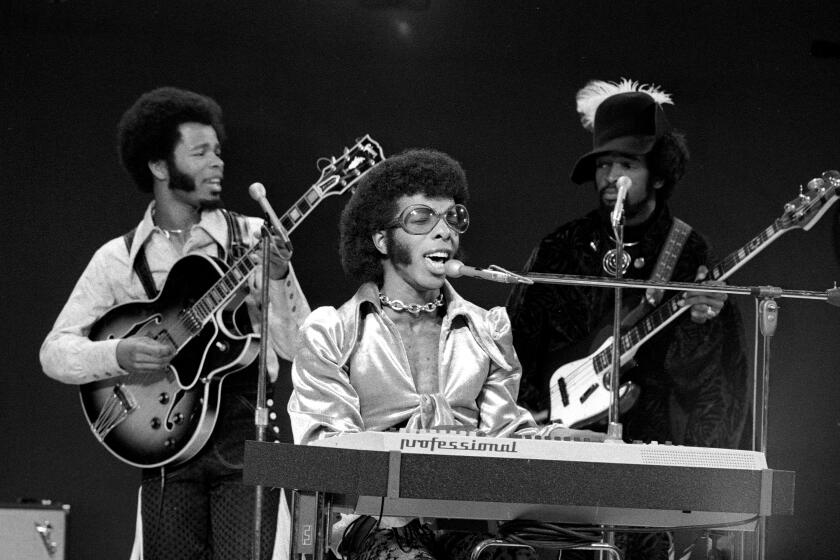Bands creating their own mini-Coachellas
- Share via
This post has been corrected. Details at the bottom.
Winston Marshall of the band Mumford & Sons has roofing on his mind.
Although music often occupies the multi-instrumentalist’s thoughts, this day there are more pressing matters: The British folk-rock band is bringing a group of hand-picked artists to the U.S. in August for its four Gentlemen of the Road festivals, and the question is whether each stage should get a roof — or is that money best spent elsewhere?
“In Galway, we did one without a roof and it was absolutely pouring down. We might have half a roof and see how it goes,” Marshall says, before half-joking, “At least all our drummers will be OK.”
The number of music festivals such as Coachella in California and Bonnaroo in Tennessee is on the upswing, and a lot of artists are getting into the act on a smaller scale by creating their own events. Metallica, Mumford & Sons and Jay-Z are joining such artists as the Roots, Disco Biscuits, the Zac Brown Band and Drake, who already run their own annual fests, some featuring up to 75 acts. Cage the Elephant is curating a festival in their Kentucky hometown, while the Afghan Whigs’ Greg Dulli will curate the I’ll Be Your Mirror USA festival in September.
“Musicians want to expand their artistic expression, and this is a good way of doing it by highlighting the influences of other artists they listen to and current artists that are happening,” says Geoffrey Gordon, president of Live Nation Philadelphia. His company partnered with the Roots for its fifth annual Picnic, which grew from one to two days in June. The company is also teaming up with Jay-Z for the inaugural Made in America Festival, whose roster includes Pearl Jam, Skrillex and D’Angelo. It’ll be held Sept. 1 and 2 in Philadelphia.
The patron saint of artist-created festivals is Perry Farrell of Jane’s Addiction. In 1991, he started Lollapalooza as a multi-artist traveling festival, later resurrecting it as a static event in Chicago in 2005.
Finding a good partner is essential, says Farrell, who pairs with William Morris Endeavor Entertainment and C3 Presents for Lollapalooza. “You’re not going to be able to compete solely on your own,” he says. “If you’re going to do a big shindig, you need some help.”
In some cases, the artists own the festival and are involved with every facet of the event. In others, they limit their participation to performing and picking the other artists.
The Zac Brown Band launched the Southern Ground Music and Food Festival in Charleston, S.C., last year. This fall, the band-owned event expands to Nashville — on its way, Brown hopes, to an eventual tour including up to 10 locations.
“We asked ourselves, ‘What would I want to have if I was at a festival?’” Brown says. “I’d want to have amazing food and drink and see an eclectic group of artists play. Too much of any one kind of music for six hours in a row is going to wear people out.” Last year’s festival bill included My Morning Jacket, Train, Steel Pulse and Fitz & the Tantrums.
As the idea spreads, competition for the top acts grows fiercer. Metallica drummer Lars Ulrich says the band and its partner, C3 Presents, originally wanted to hold the inaugural Orion Music + More festival in 2011, but “we were too late getting to the bands we were interested in,” he says.
“The thing I learned is if we’re going to be fortunate to do it again in 2013, we better start booking [immediately].”
Among the three-dozen acts hand-picked by Metallica for Orion, held June 23-24, were Eric Church, Modest Mouse, Avenged Sevenfold and Suicidal Tendencies.
There’s definitely money to be made for established festivals: Indio’s Coachella grossed $47 million this spring in its first year to span two weekends, according to Billboard. Its Los Angeles-based producer, Goldenvoice, did not divulge net revenue.
But Ulrich says his band did not make a dime from its first Orion festival, and it even headlined both nights for free. “Can you say longevity?” Ulrich says. “This is an investment. You don’t do it for the money; you do it for the passion. This is to try to get something together that’s fun for us and our fans.”
To that end, Metallica added several attractions to highlight the band members’ offstage interests, including a custom car show, reflecting lead singer James Hetfield’s love of automobiles, and Kirk’s Crypt, a collection of horror memorabilia amassed by guitarist Kirk Hammett.
“Last year wasn’t a total loss,” Brown says. “The rule of thumb is you lose money the first year, break even the second, and in Year 3 make money. We’re building something.”
As with real estate, part of the secret is location. Ulrich says Metallica strategically picked Atlantic City, N.J., to appeal to its traveling European and U.S. fans, and because the group wanted an urban setting instead of the usual bucolic field with a “7-inch-wide dirt road running in each direction.”
Mumford & Sons chose four smaller cities that are often bypassed on concert routes and that could meet the band’s mandate to provide only local food and drink, Marshall says. All four Gentlemen events have already sold out with capacity between 15,000 and 20,000 people.
Regardless of the event’s size, Farrell’s advice to his fellow artists entering the festival business is to remember their hosting duties and the comfort of their patrons: “Look at it like it’s a party you’re throwing; have pride in your party. It’s not just you’re [putting] up a stage. You have to think about what they’re going to drink, eat, how they’re going to feel and where they’re going to sit. It’s that easy and it’s that complicated.”
[For the record, July 18, 3:05 PM: In an earlier version of this story we referred to Winston Marshall as Wilson Marshall.]
ALSO:
TIMELINE: Coachella through the years
More to Read
The biggest entertainment stories
Get our big stories about Hollywood, film, television, music, arts, culture and more right in your inbox as soon as they publish.
You may occasionally receive promotional content from the Los Angeles Times.










